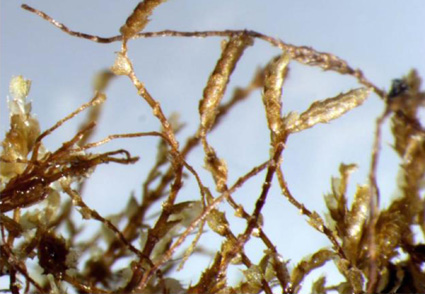Abstract
The new liverwort species Chiastocaulon raetzelii is described from New Caledonia. Chiastocaulon raetzelii is characterized by very fragile, caducous leaves, stems therefore often becoming completely denuded of leaves; only bract leaves of the androecia are permanent and often the only ones remaining on the stem. Plants are minute with leafy shoots to 1 mm wide. Leaves on leafy shoots are arranged in opposing pairs, they are obovate-truncate to spathulate, with 3–7 teeth per leaf, teeth are filiform, consisting of long rectangular cells, and occupy about 1/3 to 1/4 of the entire leaf length. The species is compared to C. oppositum and C. geminifolium, which are the most similar morphologically.
References
Carl, H. (1931) Morphologische Studien an Chiastocaulon Carl, einer neuen Lebermoosgattung. Flora 126: 45–60. https://doi.org/10.1016/S0367-1615(17)31155-2
De Notaris, G. (1874) Epatiche di Borneo raccolte dal dre O. Beccari nel ragiato di Sarawak durante gli anni 1865-66-67. Stamperia reale di G. P. Paravia, Torino, 86 pp.
Dugas, M. (1928) Contribution à l’étude du genre “Plagiochila” Dum. Thèse, Faculté de Sciences, Université de Paris (ser. A, n. 1170), 199 pp.
Dugas, M. (1929) Contribution à l’étude du genre “Plagiochila” Dum. Annales des sciences naturelles, botanique, ser. 10, 11: 1–199.
Grolle, R. (1995) The Hepaticae and Anthocerotae of the East African islands: an annotated catalogue. Bryophytorum Bibliotheca 48: 1–178.
Hattori, S. (1947) Five new genera of Hepaticae. Biosphaera 1: 3–7.
Herzog, T. (1950) Hepaticae Borneenses (Oxford University Expedition to Sarawak. 1932). With introductory ecological notes by P.W. Richards. Transactions of the British Bryological Society 1: 275–326. https://doi.org/10.1179/006813850804878680
Inoue, H. (1964) The genus Plagiochilion. Journal of the Hattori Botanical Laboratory 27: 51–72.
Kitagawa, N. (1972) Notes on little-known species of Hepaticae, 1–25. Journal of the Hattori Botanical Laboratory 36: 444–454.
Lindberg, S.O. (1869) Nya mossor. Öfversigt af Finska Vetenskaps-Societetens Förhandlingar 12 (2): 70–84.
Lindberg, S.O. & Lackström, E.F. (1874) Hepaticae Scandinavicae exsiccata quarum specimina, fasc. 1. 25 pp.
Mitten, W. (1861) Musci et Hepaticae Vitienses. Bonplandia (Hannover) 9: 365–367.
Mitten, W. (1871) Ordo CIX. Jungermanniae. In: Seemann, B.C. (Ed.) Flora Vitiensis. L. Reeve and Co., London, pp. 404–419.
Nees von Esenbeck, C.G.D. (1830) Enumeratio Plantarum Cryptogamicarum Javae et insularum adjacentium etc. Fasciculus prior Hepaticas complectens. Sumtibus Grassii, Barthii et Soc., Vratislaviae [Breslau], 86 pp.
Paris, E.G. (1910) Hépatiques de Nouvelle-Calédonie (3e art.). Revue bryologique 37: 128–132.
Patzak, S.D., Renner, M.A.M., Schäfer-Verwimp, A., Feldberg, K., Heslewood, M.M., Peralta, D.F., de Souza, A.M., Schneider, H. & Heinrichs, J. (2016) A phylogeny of Lophocoleaceae-Plagiochilaceae-Brevianthaceae and a revised classification of Plagiochilaceae. Organisms Diversity Evolution 16 (3): 481–495. https://doi.org/10.1007/s13127-015-0258-y
Reinwardt, C.G.C., Blume, C.L. & Nees von Esenbeck, C.G. (1824) Hepaticae Iavanicae. Nova Acta Physico-medica Academiae Caesareae Leopoldino-Carolinae Naturae Curiosorum Exhibentia Ephemerides sive Observationes Historias et Experimenta 12: 183–238.
Renner, M.A.M., Heslewood, M.M., Patzak, S.D.F., Schäfer-Verwimp, A. & Heinrichs, J. (2016) The genera Chiastocaulon, Cryptoplagiochila and Pedinophyllum (Plagiochilaceae) in Australia. Australian Systematic Botany 29: 358–402. https://doi.org/10.1071/SB16029
Renner, M.A.M. & Worboys, S. (2018) Two additional Chiastocaulon species (Marchatiophyta: Plagiochilaceae) from the Wet Tropics Bioregion of north-eastern Queensland. Australian Systematic Botany 31: 487–494. https://doi.org/10.1071/SB18014
Schiffner, V. (1900) Die Hepaticae der Flora von Buitenzorg, Band 1. E. J. Brill, Leiden, 220 pp.
Schiffner, V.F. (1910) Über die Gattungen Chiloscyphus und Heteroscyphus n. gen. Oesterreichische Botanische Zeitschrift 60 (5): 169–173. https://doi.org/10.1007/BF01631854
Schuster, R.M. (1963) Studies on antipodal Hepaticae. I. Annotated keys to the genera of antipodal Hepaticae with special reference to New Zealand and Tasmania. Journal of the Hattori Botanical Laboratory 26: 185–309.
Schuster, R.M. (1970) Studies on Antipodal Hepaticae, III. Jubulopsis Schuster, Neohattoria Kamimura and Amphijubula Schuster. Journal of the Hattori Botanical Laboratory 33: 266–304.
Schuster, R.M. (1992) The Hepaticae and Anthocerotae of North America. Vol. 5. Columbia University Press, New York, 854 pp.
Stephani, F. (1908) Hépatiques de la Nouvelle-Calédonie et du Tonkin. Revue Bryologique 35: 28–35.
Stephani, F. (1910) II. Hepaticae. pp. 193–201. In: Rechinger, K. (Ed.) Botanische und zoologische Ergebnisse einer wissenschaftlichen Forschungsreise nach den Samoainseln, dem Neuguinea-Archipel und den Salomonsinseln. III. Teil. Denkschriften der Kaiserlichen Akademie der Wissenschaften, Wien. Mathematisch-naturwissenschaftliche Klasse 85: 175–432.
Stephani, F. (1924) Species Hepaticarum, Vol. 6. Georg & Cie, Geneva, 762 pp.
Thouvenot, L., Gradstein, S.R., Hagborg, A., Söderström, L. & Bardat, J. (2011) Checklist of the liverworts and hornworts of New Caledonia. Cryptogamie, Bryologie, 32: 287–390. https://doi.org/10.7872/cryb.v32.iss4.2011.287
Vá?a, J., Hentschel, J. & Heinrichs, J. (2010) New combinations in Jungermanniales: transfer of 32 taxa to Solenostoma Mitt. Cryptogamie, Bryologie 31 (2): 135–139.


